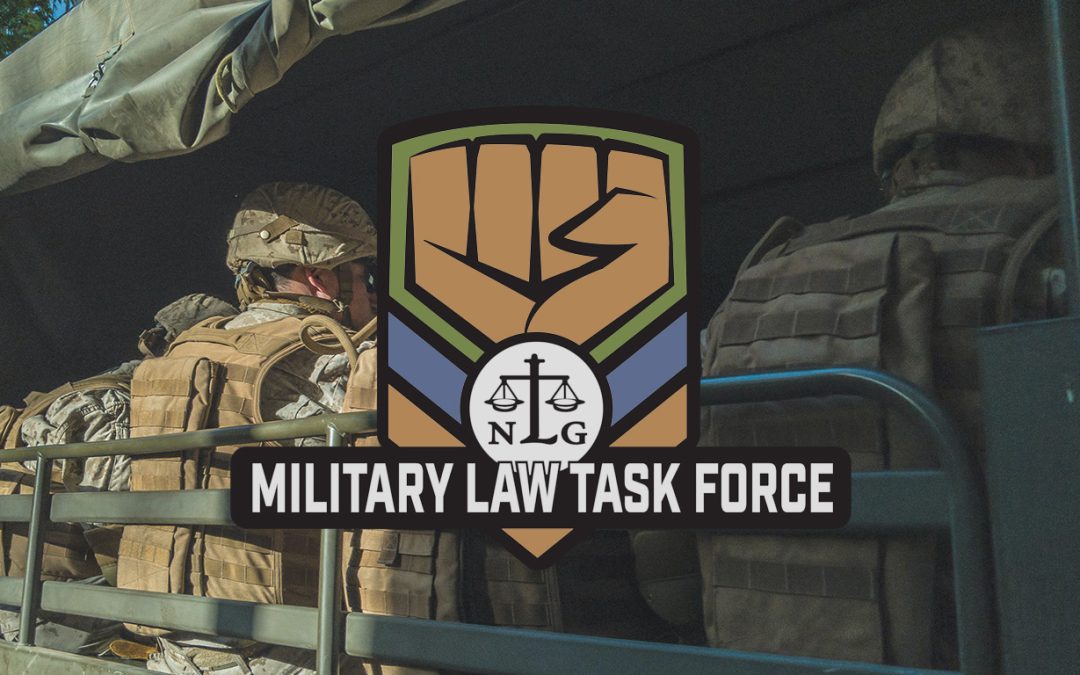BY ANA MARIA BONDOC
Signed into law on December 17, 2019, the National Defense Authorization Act (NDAA) for Fiscal Year 2020 contained a handful of noteworthy provisions related to immigration. These included a) some protection from military discharge solely due to immigration status; b) a difficult-to-enforce provision for considering military service in removal determinations; c) guidance on military parole in place, which differed from the prior policy; and d) provisions that fall short of correcting the failures that have led to the unnecessary deportation of veterans.[1]
Highlighting these immigration-related provisions, this article notes the myriad hurdles still faced by non-citizen servicemembers, family, and veterans. Appendix A contains the text of sections 570B, 1758, 526, and 530(A). My thanks to Paul Butler of the American Immigration Lawyers Association’s Military Assistance Project (AILA MAP) for participating in our Q&A on military parole in place, included as Appendix B.
PROTECTION FOR CURRENTLY SERVING DACA AND TPS RECIPIENTS
Section 570B(a) defines “covered members” who are protected from involuntary discharge solely because of their immigration status. This list is limited to persons holding a work authorization issued
under Deferred Action for Childhood Arrivals (DACA), and persons in a temporary protected status
(TPS).2
When it comes to the administrative discharge of an enlisted member, command discretion plays a large part.3 We do not have any reports of DACA and TPS recipients, serving in the military, who were fighting such a discharge.[2] As a practical matter, it may be difficult to prove that immigration status was the sole reason. The covered member would need to show, at a minimum, that decision makers were aware of their immigration status and desired to separate them because of it. Likely, the member would also bear the burden of proving that no disciplinary, performance, or other issues contributed to the decision to discharge them. For these reasons, it is unclear how many people will benefit from this provision.
CHALLENGES IN FAIR CONSIDERATION OF MILITARY SERVICE BY “IMMIGRATION OFFICIALS”
At first read, Section 570B(b) is a boon to current and former servicemembers at risk for deportation. “Immigration officials” must consider “evidence of service” as a “member of the Armed Forces” in all phases of a removal.[3] This presumably favorable consideration is to begin when deciding whether to issue a notice to appear (NTA) in the first place, through and including whether to execute a final order of removal.[4]
There is at least one foreseeable difficulty with implementing this law: proving military service. “Immigration officials” belong to one of three deporting apparatuses – U.S. Citizenship and Immigration Services (USCIS), U.S. Immigration and Customs Enforcement (ICE), and U.S. Customs and Border Patrol. USCIS, however, routinely mails NTAs without previously speaking with the individual. Should this practice continue, it could violate Section 570(B). Yet compliance will not be as easy as checking a database to verify whether an individual is a current or former “member of the Armed Forces.” No such comprehensive database exists.[5]
ICE and Customs and Border Patrol agents are at least in the practice of speaking with individuals
- The term “covered members” should not be confused with “covered individuals” as defined in Section 1758, further discussed below.
- See Department of Defense Instruction (DODI) 1332.14 Enlisted Administrative Separations, effective April 12,
2019 (available at https://www.esd.whs.mil/Portals/54/Documents/DD/issuances/dodi/133214p.pdf?ver=2019–03–14–132901–
before initiating adverse proceedings. Officials should begin screening for military service at every interaction, as it is a mandatory consideration under Section 570(B)(b). They will likely benefit from additional training with respect to military cultural competency and the types of discharge that a servicemember may receive. They must also receive training in how to identify “evidence of service.” On its face, this language is not so restrictive as to require a DD 214 or NGB Form 22.[6]
BOTH MORE AND LESS: CONGRESS’ TAKE ON MILITARY PAROLE IN PLACE
By applying for military parole in place, certain family members can obtain an Arrival/Departure Record and the possibility of adjusting their status in the future, even if they entered the United States without inspection.[7] Though the legislative history of Section 1758 suggests the aim of codifying codify parole in place for this community, it remains to be seen whether immigration policy will be amended to conform to this provision. As of this writing, the USCIS has not updated its webpage on military parole in place to reflect this law.[8] Specifically, the webpage’s list of eligible persons does not align with the new definition of “covered individual.”
This is can be both a good and a bad thing: when compared to the old list of eligible persons, the new list of “covered individuals” is more inclusive in some ways, and less inclusive in others. Before, this relief was available to a spouse, “widow(er)”, parent, son, or daughter of an active-duty member of the armed forces; an individual in the Selected Reserve of the Ready Reserve; or a veteran, who was not dishonorably discharged.[9] Now, “covered individuals” does not mention veterans.[10] In addition, if they are not deceased, a covered individual must support their parent’s request for military parole in place. Whether or not most such parents would likely have it, such support it is not required of spouses, sons, and daughters applying for military parole in place.
Despite these omissions, the new list is more inclusive by encompassing every “member of the Armed forces,”[11] not just active duty members and individuals in the Selected Reserve of the Ready Reserve. Time will tell whether any of this will affect rates of granting parole in place applications, as the provision reaffirms that consideration is on a case-by-case basis. In Appendix B, Paul Butler of AILA MAP gives his take on preparing a successful application.
PAPERWORK AND RED TAPE: HICCUPS IN NATURALIZATION THROUGH MILITARY SERVICE
Finally, a pair of provisions did not go far enough when it comes to smoothing the path to naturalization under sections 328 and 329 of the Immigration and Nationality Act.[12] The way in which the Department of Defense (DOD) and USCIS communicate has proved inadequate, as highlighted by the plight of unnecessarily deported veterans.[13]
Section 526 was geared at addressing the certification of service through Form N-426.16 An applicant’s naturalization will not move forward unless the DOD submits it on their behalf, which has created significant delays. A prior court order required the DOD to use best efforts to respond within two business days under certain circumstances.[14] As of April 2020, the DOD’s reply to Section 526 is that it will complete Form N-426s within thirty days.[15]
Fundamentally, this provision did not address the flaws with Form N-426 itself. The service requirements differ depending on whether the application is based on wartime or peacetime service. Yet, USCIS instructs applicants to use the same form. With no way to differentiate, applicants face additional delays through no fault of their own. Similarly, the DOD policy of responding within thirty days only covers applications based on wartime service.19
The feasibility study mandated by Section 530(A) is due on June 18, 2020, but we anticipate delay in part due to the COVID-19 pandemic. If Congress does not prioritize meaningful reflection on the underlying issues that prevent otherwise eligible servicemembers from being naturalized, very little may come of this provision.
CONCLUSION
Familiarity with these provisions will enable advocates to improve services to non-citizen servicemembers, veterans, and family members navigating the broken immigration system.
Appendices A and B follow.
Ana Maria Bondoc is an attorney practicing in California. Her focus is on social justice and administrative law.
APPENDIX A
Excerpted from the full text of the NDAA 2020, available at https://www.govinfo.gov/content/pkg/CRPT–116hrpt333/pdf/CRPT–116hrpt333.pdf .
SECTION 570B. PROHIBITION ON INVOLUNTARY SEPARATION OF CERTAIN MEMBERS OF THE ARMED FORCES; CONSIDERATION OF MILITARY SERVICE IN REMOVAL DETERMINATIONS.
- PROHIBITION ON INVOLUNTARY SEPARATION.
- IN GENERAL.—No member of the Armed Forces may be involuntarily separated from the Armed Forces solely because that member is a covered member.
- COVERED MEMBER DEFINED.—In this subsection, the term ‘‘covered member’’ means a member of the Armed Forces who—
- possesses a current and valid employment authorization document that was issued pursuant to the memorandum of the Secretary of Homeland Security dated
June 15, 2012, and entitled ‘‘Exercising Prosecutorial Discretion with Respect to Individuals who Came to the United States as Children’’; or
- is currently in a temporary protected status under section 244 of the Immigration and Nationality Act (8 U.S.C. 1254a).
- CONSIDERATION OF MILITARY SERVICE IN REMOVAL DETERMINATIONS.
- IN GENERAL.—With regards to an individual, an immigration officer shall take into consideration evidence of military service by that individual in determining whether— (A) to issue to that individual a notice to appear in removal proceedings, an administrative order of removal, or a reinstatement of a final removal order; and (B) to execute a final order of removal regarding that individual.
- DEFINITIONS.—In this subsection:
- The term ‘‘evidence of service’’ means evidence that an individual served as a member of the Armed Forces, and the characterization of each period of service of that individual in the Armed Forces.
- The term ‘‘immigration officer’’ has the meaning given that term in section 101 of the Immigration and Nationality Act (8 U.S.C. 1101 et seq.).
SECTION 1758. PAROLE IN PLACE FOR MEMBERS OF THE ARMED FORCES AND CERTAIN MILITARY DEPENDENTS.
- IN GENERAL.—In evaluating a request from a covered individual for parole in place under section
212(d)(5) of the Immigration and Nationality Act (8 U.S.C. 1182(d)(5)), the Secretary of Homeland Security shall consider, on a case-by-case basis, whether granting the request would enable military family unity that would constitute a significant public benefit.
- SENSE OF CONGRESS.—It is the sense of Congress that—
- parole in place reinforces the objective of military family unity;
- except as required in furtherance of the missions of the Armed Forces, disruption to military family unity should be minimized in order to enhance military readiness and allow members of the Armed Forces to focus on the faithful execution of their military missions and objectives, with peace of mind regarding the well-being of their family members; and
- the importance of the parole in place authority of the Secretary of Homeland Security is reaffirmed.
- COVERED INDIVIDUAL DEFINED.—In this section, the term ‘‘covered individual’’ means an alien
who—
- is a member of the Armed Forces;
- is the spouse, son, or daughter of a member of the Armed Forces;
- is the parent of a member of the Armed Forces who supports the request of such parent for parole in place; or
- is the widow, widower, parent, son, or daughter of a deceased member of the Armed Forces.
SEC. 526. TIME REQUIREMENTS FOR CERTIFICATION OF HONORABLE SERVICE.
The Secretary of Defense shall publish regulations for submission and processing of a completed United States Citizenship and Immigration Services Form N–426, by a member of the Armed Forces. Such regulations shall designate the appropriate level for the certifying officer as well as establish time requirements for the form to be returned to the member of the Armed Forces.
SEC. 530A. FEASIBILITY STUDY REGARDING NOTIFICATION TO SECRETARY OF HOMELAND SECURITY OF HONORABLE DISCHARGES OF NON-CITIZENS.
- STUDY REQUIRED.—The Secretary of Defense, in consultation with the Secretary of Homeland
Security, shall study the feasibility of providing the Secretary of Homeland Security with a copy of the
Certificate of Release or Discharge from Active Duty (DD Form 214) or National Guard Report of
Separation and Record of Service (NGB-22) for each individual who is not a citizen of the United States who is honorably discharged from the Armed Forces so the Secretary of Homeland Security may note such discharge in an I–213 Record of Deportable/Inadmissible Alien for that individual.
- REPORT.—Not later than 180 days after the date of the enactment of this Act, the Secretary of Defense shall submit to the committees on Armed Services of the Senate and House of Representatives a report regarding the results of the study under this section.
Appendix B
Paul Butler, committee member of the American Immigration Lawyers Association’s Military Assistance Project (AILA MAP), gives his take on military parole in place in light of recent changes in the law. The views or opinions expressed here are solely those of the individuals involved and do not necessarily represent those of any agency of the United States of America.
Q: How can parole in place help military family members?
A: Normally, the law requires that an initial inspection and admission occurred when a non-citizen who entered the country later wishes to adjust their status. Parole in place can allow for a future adjustment of status even though the person was not initially inspected and admitted. Think of it as a legal fiction.
For a military family member who came to the U.S. under these circumstances, it’s huge that they can apply. If granted, parole in place means that when they otherwise satisfy the requirements for adjustment of status, they can take those next steps.
Q: Military parole in place remains something that immigration officials can grant at their discretion. How can advocates improve their clients’ chances of success?
Applications need to emphasize the negative impact that family separation would have on the servicemember. Avoiding this would be the significant public benefit, harkening back to one of the original justifications for parole. Depending on the facts you have, you can make a compelling case that this is a military readiness issue, a national security issue: to support servicemembers and ease their concerns that their family will be deported.
Q. Various parole policies have been around since the early 1950s, but in this law, veterans are not listed as covered persons. What can this mean for veteran family members who wish to apply for parole in place?
It may just be that veterans’ affairs fall under the purview of another committee, rather than a deliberate exclusion. Unless the USCIS policy changes, indications are that parole in place for veteran family members are still being considered on a case-by-case basis.
To return to your previous question, military readiness may not be the strongest argument when the application is for a veteran’s family member. Develop facts to show how the family member’s continued presence is a significant public benefit. In a case of a veteran living with physical disabilities, how does the family member assist with their activities of daily living? Without the family member, would the veteran be forced to rely on public assistance and thus be a burden to local social services agencies?
Also, do not overlook the toll that family separation can have on the veteran’s psychological and emotional well-being. Given the nation’s strong interest in veteran welfare and in the prevention of veteran suicide, these are highly relevant in showing that a family member’s parole would be a significant public benefit.
[1] Appendix A contains the text of sections 570B, 1758, 526, and 530(A) which are discussed in this article.
[2] Given recent and ongoing litigation for some enlistees under the Military Accessions Vital to the National Interest (MAVNI) Program, this provision may protect MAVNI enlistees who were not included in these class actions. See Kirwa, et al. v. U.S. Dep’t of Defense, et al., Civil Action No. 17-1793 and Nio, et al. v. U.S. Dep’t of Defense, et al., Civil Action No. 17-0998.
[3] Section 570(B)(b).
[4] Id.
[5] The closest thing may be the embattled Servicemembers’ Civil Relief Act (SCRA) website. https://scra.dmdc.osd.mil/scra/#/home (last reviewed June 15, 2020). Recently, the Department of Defense agreed to settle alleged Privacy Act violations in the operation of the SCRA website. See Settlement Agreement, Vietnam Veterans of America, et. al. v. U.S. Dep’t of Defense, et. al., Case no. 17-cv-730-LJV (W.D.N.Y. October 3, 2019). This site, however, is only designed to identify those in a Title 10 (federal) active duty status at the time the search is executed. Veterans, Reservists, and members of the National Guard who are not activated under Title 10, are excluded. Though no less worthy, this group is at risk of missing out on the protection from deportation that Section 570B(b) was intended to provide.
[6] These well-known separation documents are not universally issued. For example, Reservists may not receive a DD 214 aside from their initial entry training, though they may serve for many years. National Guard members completing Title 32 (state) active duty may not receive an NGB Form 22, either.
[7] Regarding form I-94, see https://www.uscis.gov/I–94information (last reviewed June 15, 2020). See also
Appendix B for more on military parole in place applications. See also Practice Alert: Denials and Refusals to Adjudicate Military Parole in Place Applications, September 4, 2019, AILA Doc. No 19083036 (available at https://www.aila.org/advo–media/aila–practice–pointers–and–alerts/practice–alert–denials–and–refusals–toadjudicate) Advocates report that USCIS has resumed processing military parole in place applications since this provision passed.
[8] https://www.uscis.gov/military/discretionary–options–military–members–enlistees–and–their–families (last reviewed June 15, 2020).The presumably relevant portions of the USCIS Policy Manual (“Protection and Parole Policies and Procedures” at Volume 3, Part A) are not readily available. See https://www.uscis.gov/policymanual/toc .
[9] https://www.uscis.gov/military/discretionary–options–military–members–enlistees–and–their–families.
[10] Section 1785(c)(1).
[11] Id.
[12] See Appendix A, Sections 526, and 530(A). The statutory basis for naturalization through peacetime service is codified at 8 U.S.C. § 1439, and 8 U.S.C. §1440 for peacetime service.
[13] Bardis Vakili et. al., Discharged, then Discarded, A Report by the ACLU of California (July 2016) (available at https://www.aclusandiego.org/wp–content/uploads/2017/07/DischargedThenDiscarded–ACLUofCA.pdf). 16 In 2017, advocates were dismayed when the DOD unilaterally imposed more requirements before it would agree to complete this form. Kurta, Memorandum RE: Certification of Honorable Service for Members of the Selected Reserve of the Ready Reserve and Members of the Active Components of the Military or Naval Forces for Purposes of Naturalization, Office of the Undersecretary of Defense (October 13, 2017)(available at https://dod.defense.gov/Portals/1/Documents/pubs/Naturalization–Honorable–Service–Certification.pdf). This spring, six non-citizen servicemembers initiated a federal suit arguing that the additional criteria imposed are in violation of the law. Complaint, Samma et. al. v. U.S. Dep’t of Defense and Mark Esper Civil Action No. 1:20-cv01104-ESH (D.D.C. April 28, 2020).
[14] Amended Order, Kirwa et. al. Kirwa, et al. v. U.S. Dep’t of Defense, et al., Civil Action No. 17-1793 (D.D.C.
October 27, 2017).
[15] Donovan, Certification of Honorable Service for Purposes of Naturalization, Office of the Undersecretary of Defense (April 24, 2020)(on file with author). 19 Id., referencing 8 U.S.C. §1440.



